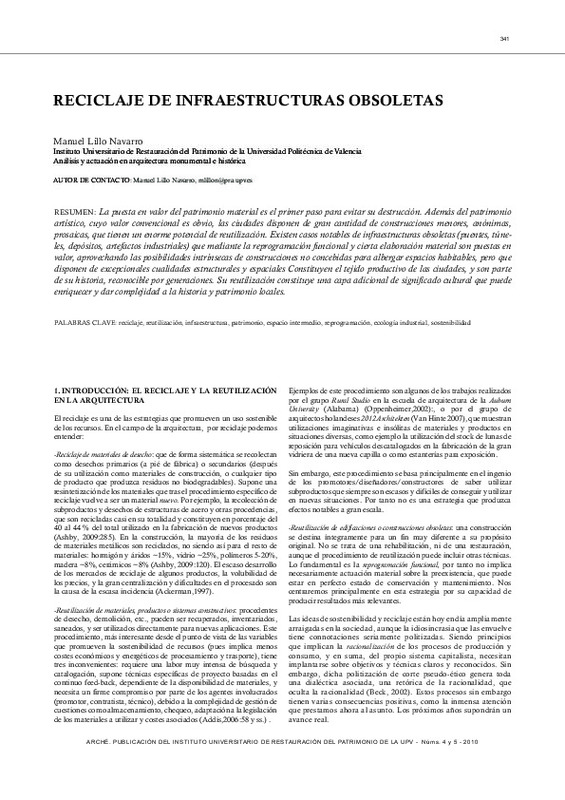JavaScript is disabled for your browser. Some features of this site may not work without it.
Buscar en RiuNet
Listar
Mi cuenta
Estadísticas
Ayuda RiuNet
Admin. UPV
Reciclaje de infraestructuras obsoletas
Mostrar el registro sencillo del ítem
Ficheros en el ítem
| dc.contributor.author | Lillo Navarro, Manuel
|
es_ES |
| dc.date.accessioned | 2013-07-15T07:23:16Z | |
| dc.date.available | 2013-07-15T07:23:16Z | |
| dc.date.issued | 2010 | |
| dc.identifier.issn | 1887-3960 | |
| dc.identifier.uri | http://hdl.handle.net/10251/31136 | |
| dc.description.abstract | La puesta en valor del patrimonio material es el primer paso para evitar su destrucción. Además del patrimonio artístico, cuyo valor convencional es obvio, las ciudades disponen de gran cantidad de construcciones menores, anónimas, prosaicas, que tienen un enorme potencial de reutilización. Existen casos notables de infraestructuras obsoletas (puentes, túneles, depósitos, artefactos industriales) que mediante la reprogramación funcional y cierta elaboración material son puestas en valor, aprovechando las posibilidades intrínsecas de construcciones no concebidas para albergar espacios habitables, pero que disponen de excepcionales cualidades estructurales y espaciales Constituyen el tejido productivo de las ciudades, y son parte de su historia, reconocible por generaciones. Su reutilización constituye una capa adicional de significado cultural que puede enriquecer y dar complejidad a la historia y patrimonio locales. | es_ES |
| dc.description.abstract | Restoring the value of material heritage is the first step towards preventing its destruction. Apart from artistic heritage, whose conventional value is obvious, cities have a large number of minor, anonymous, prosaic constructions which have an enormous potential for reuse. There are noteworthy cases of obsolete infrastructures (bridges, tunnels, deposits, industrial artefacts) which can have their value brought back by means of functional reprogramming and some material preparation, taking advantage of the intrinsic possibilities of constructions not conceived for containing inhabitable spaces, but which have outstanding structural and spatial qualities. These constitute the production fabric of cities and are part of their history, recognisable for generations. Their reuse constitutes a further stratum of cultural significance which may enrich and give complexity to local history and heritage. | es_ES |
| dc.format.extent | 8 | es_ES |
| dc.language | Español | es_ES |
| dc.publisher | Instituto Universitario de Restauración del Patrimonio de la UPV | es_ES |
| dc.relation.ispartof | Arché | es_ES |
| dc.rights | Reserva de todos los derechos | es_ES |
| dc.subject | Reciclaje | es_ES |
| dc.subject | Reutilización | es_ES |
| dc.subject | Infraestructura | es_ES |
| dc.subject | Patrimonio | es_ES |
| dc.subject | Espacio intermedio | es_ES |
| dc.subject | Reprogramación | es_ES |
| dc.subject | Ecología industrial | es_ES |
| dc.subject | Sostenibilidad | es_ES |
| dc.subject | Recycling | es_ES |
| dc.subject | Reuse | es_ES |
| dc.subject | Infrastructure | es_ES |
| dc.subject | Heritage | es_ES |
| dc.subject | Intermediate space | es_ES |
| dc.subject | Reprogramming | es_ES |
| dc.subject | Industrial ecology | es_ES |
| dc.subject | Sustainability | es_ES |
| dc.subject.classification | CONSERVACION Y RESTAURACION DE BIENES CULTURALES (UPV) | es_ES |
| dc.title | Reciclaje de infraestructuras obsoletas | es_ES |
| dc.title.alternative | Recycling obsolete infrastructures | es_ES |
| dc.type | Artículo | es_ES |
| dc.rights.accessRights | Abierto | es_ES |
| dc.contributor.affiliation | Universitat Politècnica de València. Instituto Universitario de Restauración del Patrimonio - Institut Universitari de Restauració del Patrimoni | es_ES |
| dc.description.bibliographicCitation | Lillo Navarro, M. (2010). Reciclaje de infraestructuras obsoletas. Arché. (4-5):341-348. http://hdl.handle.net/10251/31136 | es_ES |
| dc.description.upvformatpinicio | 341 | es_ES |
| dc.description.upvformatpfin | 348 | es_ES |
| dc.description.issue | 4-5 | |
| dc.identifier.eissn | 2445-1150 |






